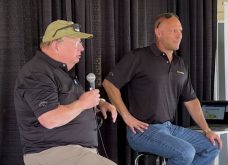Fed cattle fall
For the week, fed cattle prices averaged $1.50 lower than the week before, Canfax said.
The news on March 31 on the expected reduced U.S. area seeded to corn continued to hang on the market last week. The implication of higher feed prices served to pressure cattle futures prices lower.
Slightly more than 25,000 head sold, up 13 percent from the week before.
The market started out sluggish, saw its best pricing midweek and then eased off again into the close.
Read Also

One Beer Market Updates Day 3 – Lentils and beef
Day 3 of the One Beer Market Update at Ag in Motion 2025.
Fed cattle exports cracked the 20,000 head mark for the first time since the border opened last July.
Alberta prices April 6 were steers $82-$85 per cwt., flat rail $138.20-$142 and heifers $141-$142.
The Good Friday holiday will reduce slaughter this week.
Canfax expects packers will start to increase fed cattle kill. This might help basis levels. Recent national federal slaughter has been only 50,000 head per week.
Beef weakens
U.S. cut-out values fell, with Choice down $1.80 US and Select down $1.30 from the week before, Canfax said.
The lower prices triggered better movement, helping to reverse the buildup of end meat inventories.
Canadian cutouts also fell. Alberta packers lowered wholesale prices for delivery this week with prices $2-$3.50 lower in a range of $143-$144.50 on handyweight steers.
Retail buying interest continues to be considered light with ample competitive meats offered and most features going to pork or poultry, said Canfax.
Feeder market down
Feeder cattle prices followed fed cattle lower, Canfax said.
Steers 700-900 pounds and heavier were down $1.75-$3.75 and heifers 700-900 and heavier fell $1.50-$3.50.
Steer calves 300-400 lb. rose 25 cents, while heifer calves were down $1.75.
Light steers 400-500 lb. were down $2.75, steers 500-600 lb. rose 25 cents and steers 600-700 lb. were down $1.50.
Heifers 400-700 lb. fell $1.75-$3.
Alberta auction market volumes were up six percent at 40,605 head. Year-to-date volume is 520,215 head, up 17 percent from a year ago.
D1, 2 cows traded stronger with prices up 75 cents to average $39.34. Butcher bulls rose 50 cents to average $35.27.
Canfax said the bleak summer forecast and negative feeding margins would keep downward pressure on heavy feeder cattle prices.
Grass cattle will probably trade steady, depending on quality.
Feeder volumes will start to fall toward the end of the month.
One factor supporting feeder prices is continued U.S. buyer interest. Feeder cattle exports for the week ending March 31 totalled 9,828 head.
Stock bred cows were mostly steady at $850-$1,300, plain types $500-$800. Northern Alberta plain bred heifers were $650-$900.
Cow-calf pairs traded lower with most at $875-$1,350 and plain types $650-$850.
Hog prices drop
An ample supply of hogs and large supplies of competing meat types caused hog prices to fall again last week.
Also weighing on prices was the reduced slaughter week because of Good Friday. Also, Tyson Foods Inc., the largest meat producer in the United States, cut production for one day on April 10 in response to poor market conditions and concerns a nationwide immigration rally that day would affect attendance by its Hispanic workers.
The composite pork carcass cut-out value fell to $56.08 US per cwt. April 7, down from $58.17 March 31.
The Iowa-southern Minnesota live cash price for hogs delivered to plants fell to $38.50 per cwt. April 7, compared to $40.50 March 31.
Federal slaughter in the U.S. was estimated at 1.992 million last week, up a little from 1.973 million the week before.
Sheep steady
Ontario Stockyards Inc. reported 3,910 sheep and lambs and 717 goats traded. All classes of sheep, lambs and goats sold at steady prices.
















